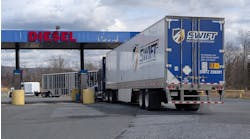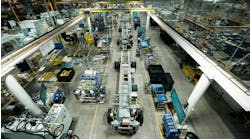The North American Council for Freight Efficiency (NACFE) said 6x2 axle configurations continue to offer “an undeniable fuel consumption improvement,” but adoption rates remain fairly low due to higher tire wear, poor residual values, and a negative perception.
The group issued a new report on July 11, updating its comprehensive confidence report from January 2014. NACFE said newer product offerings, including liftables, are likely to reduce some of the challenges early adopters of 6x2 axle configurations have previously faced.
In a 6x2 configuration, only one of the tractor’s rear axles is powered, rather than both axles like in a 6x4 configuration. That means there is less rolling resistance and drag, resulting in fuel savings of about 2.5%. NACFE said in 2014 that fleets should have a medium-to-high confidence in a two-year payback.
“While the fuel savings as well as the benefits and challenges still largely hold today, the relative value of the benefits versus challenges has changed significantly, primarily due to lower fuel prices,” the updated report said.
Early adopters of what NACFE classifieds as “generation I” axles suffered from up to a 70% reduction in tire life on drive tires in some cases. That played a significant role in creating a negative perception about 6x2-equipped vehicles.
However, it is an attitude that appears to be moderating.
“Through a combination of best practices and adoption of complementary technologies, fleets have found that 6x2 axles work for their application and are benefitting from the improved fuel consumption. Refinements include mitigating tire wear, selecting the appropriate tire, improving traction, using a liftable 6x2, and training and communicating with drivers,” the report said.
The report discussed “generation II,” which is 6x2 configuration with tag axle, manual or automated load-shifting, traction control, engine parameters adjusted to reduce low speed, clutch engagement, and engine brake torque. These can mitigate traction issues and improve tire wear, NACFE said.
It also classified “generation III” - a 6x2 with liftable pusher axle, automatic load sensing, traction control, and engine parameters to limit low speed/brake torque. NACFE called this a good option for fleets expecting to carry less than 60,000 lbs. at least 30% of the time, thus adding potentially an additional 2% fuel savings.
“Various fleets have cited fuel efficiency benefits of a liftable axle in long-haul duty cycles, as well as better traction and improved tire life and drivability. However, liftable systems do have some challenges vs. standard 6x2 systems such as increased cost and weight,” the report said.
NACFE recommended fleets gain knowledge of 6x2 tag axle systems and test the technology and their internal processes for managing engine parameters and driver training.
The report also mentioned a dual range disconnect system from Dana and an regenerative braking system from Hyliion as products spurring “interesting innovations with respect to 6x2s.”



